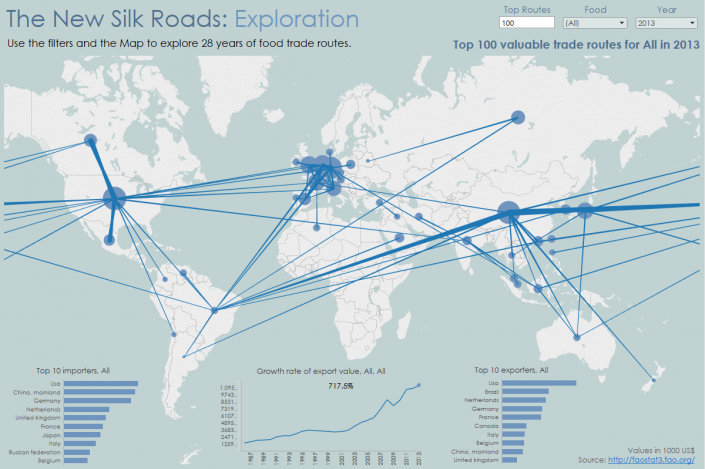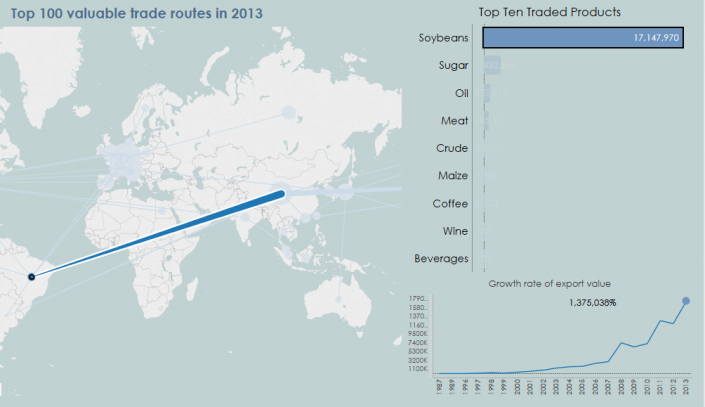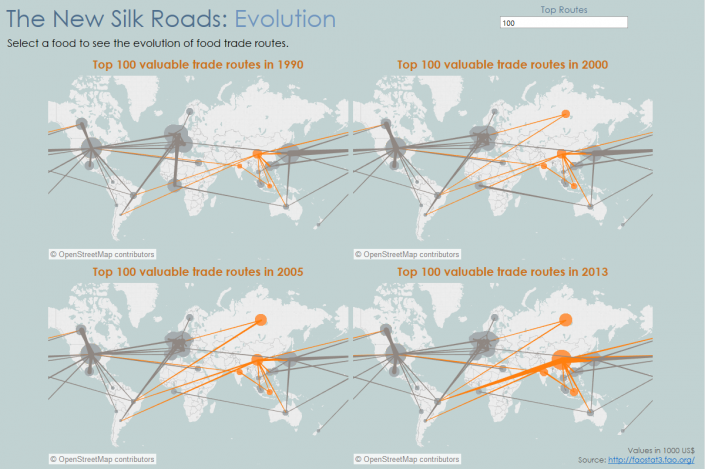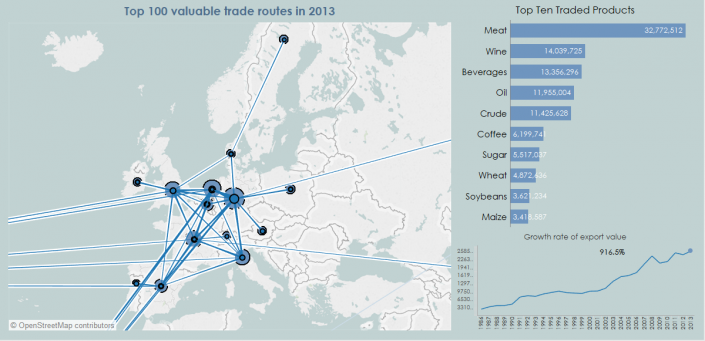24 April 2016
The Silk Road –designed UNESCO World Heritage Site in 2014- is probably the most famous trade route in the history of the world. For more than 1600 years, its network of routes has been the main driver of goods exchanges between the West and the East, as well as the main channel of political and cultural interactions.Just take it in for a moment: Thanks to the Silk Road’s trade routes, remnants of Chinese Silk have been found in Egypt from 1070 BCE!The amazing history of this network suggests that commercial routes have never been only a way to sell and buy goods, but instead they can tell several stories of relationships, politics, culture, lifestyles, and power balance.Investigating its shape over time, we can appreciate the creation of economies, and the development of great civilizations as Chinese, Indian, Persian, Roman and Syrian, among others.So, what modern commercial route would tell us, if we could interrogate them? I found 30 years’ worth of data from the FaoStat to figure it out![caption id='attachment_8299' align='aligncenter' width='705'] Click on the picture to go to the Viz![/caption]
Click on the picture to go to the Viz![/caption] The most valuable commercial route is the Soybean export to China, followed by Canadian, Mexican and Japanese routes.The Soybean’s USA- China commercial route is really big deal for world’s agriculture, and it is somehow amazing and surprising, as soybean had actually first originated in China!Its relevance for the global balances has been receiving extensive coverage from commodity analysts, and researchers (see ‘China and the Soybean Challenge’ , or 'How China’s Soybean Imports Could Affect US Exports'), and is mostly driven by the rise in demand of Chinese people, due to their increase in their living standards.China imports Soybeans mostly for making vegetable oil and high-protein meals, and recently this year approved for import Monsanto’s GMO variety of soybeans.Besides US, in the last years another big player entered the game of feeding China’s demand of soybeans: Brazil, which – according to Bloomberg – is set to displace U.S.
The most valuable commercial route is the Soybean export to China, followed by Canadian, Mexican and Japanese routes.The Soybean’s USA- China commercial route is really big deal for world’s agriculture, and it is somehow amazing and surprising, as soybean had actually first originated in China!Its relevance for the global balances has been receiving extensive coverage from commodity analysts, and researchers (see ‘China and the Soybean Challenge’ , or 'How China’s Soybean Imports Could Affect US Exports'), and is mostly driven by the rise in demand of Chinese people, due to their increase in their living standards.China imports Soybeans mostly for making vegetable oil and high-protein meals, and recently this year approved for import Monsanto’s GMO variety of soybeans.Besides US, in the last years another big player entered the game of feeding China’s demand of soybeans: Brazil, which – according to Bloomberg – is set to displace U.S. In fact, Brazil cultivation and export of soybeans skyrocketed since the early 2000, as the commercial relationships with China got stronger. In 2009, China surpassed US as Brazil’s largest trading partner (nature.org).Unfortunately, one of the main effects of the raise of Brazil in this market, is a huge impact on deforestation, as pointed out in several studies (e.g. here and here), and a threat to conservation.The galloping BRIC:The Brazil-China Soybean route brings us directly to the second main pattern of the last thirty years of food trade routes: the rise of the so called BRIC.
In fact, Brazil cultivation and export of soybeans skyrocketed since the early 2000, as the commercial relationships with China got stronger. In 2009, China surpassed US as Brazil’s largest trading partner (nature.org).Unfortunately, one of the main effects of the raise of Brazil in this market, is a huge impact on deforestation, as pointed out in several studies (e.g. here and here), and a threat to conservation.The galloping BRIC:The Brazil-China Soybean route brings us directly to the second main pattern of the last thirty years of food trade routes: the rise of the so called BRIC. Brazil, Russia, India and China are usually considered a cluster of large countries that boosted their development pace and economic growth in the last decades.However, a glance at the shapes of their food trade routes suggests very different effects of their growth in each country.
Brazil, Russia, India and China are usually considered a cluster of large countries that boosted their development pace and economic growth in the last decades.However, a glance at the shapes of their food trade routes suggests very different effects of their growth in each country. For China and Russia, the growth meant mainly an increase in the demand of food, in particular the abovementioned and diffusely covered soybeans for China, and Meat for Russia.Brazil, instead, became the second largest exporter, mainly courtesy of its boost in commercial relationships with China, but also thanks to European and Russian demand of Meat.Good Old Europe:What an amazing network of diverse – and yet united – countries and people!Europe is homeland of six between the largest food exporters (and importers) in the entire world: Netherlands, Germany, France, Italy, Belgium and United Kingdom. The commercial routes involving those countries are mainly focused on high-end products like Meat, Wine (mainly due to Italy and France) and Beverages.
For China and Russia, the growth meant mainly an increase in the demand of food, in particular the abovementioned and diffusely covered soybeans for China, and Meat for Russia.Brazil, instead, became the second largest exporter, mainly courtesy of its boost in commercial relationships with China, but also thanks to European and Russian demand of Meat.Good Old Europe:What an amazing network of diverse – and yet united – countries and people!Europe is homeland of six between the largest food exporters (and importers) in the entire world: Netherlands, Germany, France, Italy, Belgium and United Kingdom. The commercial routes involving those countries are mainly focused on high-end products like Meat, Wine (mainly due to Italy and France) and Beverages. Netherlands is the biggest food economy, exporting its products in all the EU and the US, and importing – mainly meat – from Brazil and Argentina. A fair part of its wealth is due to its strong relationship with Germany.ConclusionsThe above mentioned stories are only three among the infinite ones that this dashboard can help see and understand.The “New Silk Roads”, from a ten-million-rows dataset are here unleashed in a dashboard oriented toward exploration and user-friendliness.Explore what you are interested in, select a trade route for a particular product and see how this network has evolved, revealing shifts in global demand and power balance. Pick your favorite food, and see where it is likely to come from, but don’t forget to let me know about all the interesting things you discover!
Netherlands is the biggest food economy, exporting its products in all the EU and the US, and importing – mainly meat – from Brazil and Argentina. A fair part of its wealth is due to its strong relationship with Germany.ConclusionsThe above mentioned stories are only three among the infinite ones that this dashboard can help see and understand.The “New Silk Roads”, from a ten-million-rows dataset are here unleashed in a dashboard oriented toward exploration and user-friendliness.Explore what you are interested in, select a trade route for a particular product and see how this network has evolved, revealing shifts in global demand and power balance. Pick your favorite food, and see where it is likely to come from, but don’t forget to let me know about all the interesting things you discover!
 Click on the picture to go to the Viz![/caption]
Click on the picture to go to the Viz![/caption]A tale of multiple stories
From caravans to cargo planes, our world is now wholly globalized: nowadays, nobody would be any surprised to find Chinese silk in Egypt!Despite the trend toward globalization, the world is still clearly polarized around three big players:Uncle Sam spills his (soy)beans!USA are both the largest exporters (by far) and the largest importers of food. Their main traded products are Oil, Meat, Sugar and Beverages (Coke, anyone?), while their imports are mainly Oil, Beverages, Coffee, Sugar and Meat. The most valuable commercial route is the Soybean export to China, followed by Canadian, Mexican and Japanese routes.The Soybean’s USA- China commercial route is really big deal for world’s agriculture, and it is somehow amazing and surprising, as soybean had actually first originated in China!Its relevance for the global balances has been receiving extensive coverage from commodity analysts, and researchers (see ‘China and the Soybean Challenge’ , or 'How China’s Soybean Imports Could Affect US Exports'), and is mostly driven by the rise in demand of Chinese people, due to their increase in their living standards.China imports Soybeans mostly for making vegetable oil and high-protein meals, and recently this year approved for import Monsanto’s GMO variety of soybeans.Besides US, in the last years another big player entered the game of feeding China’s demand of soybeans: Brazil, which – according to Bloomberg – is set to displace U.S.
The most valuable commercial route is the Soybean export to China, followed by Canadian, Mexican and Japanese routes.The Soybean’s USA- China commercial route is really big deal for world’s agriculture, and it is somehow amazing and surprising, as soybean had actually first originated in China!Its relevance for the global balances has been receiving extensive coverage from commodity analysts, and researchers (see ‘China and the Soybean Challenge’ , or 'How China’s Soybean Imports Could Affect US Exports'), and is mostly driven by the rise in demand of Chinese people, due to their increase in their living standards.China imports Soybeans mostly for making vegetable oil and high-protein meals, and recently this year approved for import Monsanto’s GMO variety of soybeans.Besides US, in the last years another big player entered the game of feeding China’s demand of soybeans: Brazil, which – according to Bloomberg – is set to displace U.S. In fact, Brazil cultivation and export of soybeans skyrocketed since the early 2000, as the commercial relationships with China got stronger. In 2009, China surpassed US as Brazil’s largest trading partner (nature.org).Unfortunately, one of the main effects of the raise of Brazil in this market, is a huge impact on deforestation, as pointed out in several studies (e.g. here and here), and a threat to conservation.The galloping BRIC:The Brazil-China Soybean route brings us directly to the second main pattern of the last thirty years of food trade routes: the rise of the so called BRIC.
In fact, Brazil cultivation and export of soybeans skyrocketed since the early 2000, as the commercial relationships with China got stronger. In 2009, China surpassed US as Brazil’s largest trading partner (nature.org).Unfortunately, one of the main effects of the raise of Brazil in this market, is a huge impact on deforestation, as pointed out in several studies (e.g. here and here), and a threat to conservation.The galloping BRIC:The Brazil-China Soybean route brings us directly to the second main pattern of the last thirty years of food trade routes: the rise of the so called BRIC. Brazil, Russia, India and China are usually considered a cluster of large countries that boosted their development pace and economic growth in the last decades.However, a glance at the shapes of their food trade routes suggests very different effects of their growth in each country.
Brazil, Russia, India and China are usually considered a cluster of large countries that boosted their development pace and economic growth in the last decades.However, a glance at the shapes of their food trade routes suggests very different effects of their growth in each country. For China and Russia, the growth meant mainly an increase in the demand of food, in particular the abovementioned and diffusely covered soybeans for China, and Meat for Russia.Brazil, instead, became the second largest exporter, mainly courtesy of its boost in commercial relationships with China, but also thanks to European and Russian demand of Meat.Good Old Europe:What an amazing network of diverse – and yet united – countries and people!Europe is homeland of six between the largest food exporters (and importers) in the entire world: Netherlands, Germany, France, Italy, Belgium and United Kingdom. The commercial routes involving those countries are mainly focused on high-end products like Meat, Wine (mainly due to Italy and France) and Beverages.
For China and Russia, the growth meant mainly an increase in the demand of food, in particular the abovementioned and diffusely covered soybeans for China, and Meat for Russia.Brazil, instead, became the second largest exporter, mainly courtesy of its boost in commercial relationships with China, but also thanks to European and Russian demand of Meat.Good Old Europe:What an amazing network of diverse – and yet united – countries and people!Europe is homeland of six between the largest food exporters (and importers) in the entire world: Netherlands, Germany, France, Italy, Belgium and United Kingdom. The commercial routes involving those countries are mainly focused on high-end products like Meat, Wine (mainly due to Italy and France) and Beverages. Netherlands is the biggest food economy, exporting its products in all the EU and the US, and importing – mainly meat – from Brazil and Argentina. A fair part of its wealth is due to its strong relationship with Germany.ConclusionsThe above mentioned stories are only three among the infinite ones that this dashboard can help see and understand.The “New Silk Roads”, from a ten-million-rows dataset are here unleashed in a dashboard oriented toward exploration and user-friendliness.Explore what you are interested in, select a trade route for a particular product and see how this network has evolved, revealing shifts in global demand and power balance. Pick your favorite food, and see where it is likely to come from, but don’t forget to let me know about all the interesting things you discover!
Netherlands is the biggest food economy, exporting its products in all the EU and the US, and importing – mainly meat – from Brazil and Argentina. A fair part of its wealth is due to its strong relationship with Germany.ConclusionsThe above mentioned stories are only three among the infinite ones that this dashboard can help see and understand.The “New Silk Roads”, from a ten-million-rows dataset are here unleashed in a dashboard oriented toward exploration and user-friendliness.Explore what you are interested in, select a trade route for a particular product and see how this network has evolved, revealing shifts in global demand and power balance. Pick your favorite food, and see where it is likely to come from, but don’t forget to let me know about all the interesting things you discover!